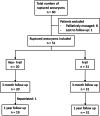Relevance of presenting risks of frailty, sarcopaenia and osteopaenia to outcomes from aneurysmal subarachnoid haemorrhage
- PMID: 35428266
- PMCID: PMC9013113
- DOI: 10.1186/s12877-022-03005-7
Relevance of presenting risks of frailty, sarcopaenia and osteopaenia to outcomes from aneurysmal subarachnoid haemorrhage
Abstract
Introduction: Aneurysmal subarachnoid haemorrhage (aSAH) is a condition with significant morbidity and mortality. Traditional markers of aSAH have established their utility in the prediction of aSAH outcomes while frailty markers have been validated in other surgical specialties. We aimed to compare the predictive value of frailty indices and markers of sarcopaenia and osteopaenia, against the traditional markers for aSAH outcomes.
Methods: An observational study in a tertiary neurosurgical unit on 51 consecutive patients with ruptured aSAH was performed. The best performing marker in predicting the modified Rankin scale (mRS) on discharge was selected and an appropriate threshold for the definition of frail and non-frail was derived. We compared various frailty indices (modified frailty index 11, and 5, and the National Surgical Quality Improvement Program score [NSQIP]) and markers of sarcopaenia and osteopaenia (temporalis [TMT] and zygoma thickness), against traditional markers (age, World Federation of Neurological Surgery and modified Fisher scale [MFS]) for aSAH outcomes. Univariable and multivariable analysis was then performed for various inpatient and long-term outcomes.
Results: TMT was the best performing marker in our cohort with an AUC of 0.82, Somers' D statistic of 0.63 and Tau statistic 0.25. Of the frailty scores, the NSQIP performed the best (AUC 0.69), at levels comparable to traditional markers of aSAH, such as MFS (AUC 0.68). The threshold of 5.5 mm in TMT thickness was found to have a specificity of 0.93, sensitivity of 0.51, positive predictive value of 0.95 and negative predictive value of 0.42. After multivariate analysis, patients with TMT ≥ 5.5 mm (defined as non-frail), were less likely to experience delayed cerebral ischaemia (OR 0.11 [0.01 - 0.93], p = 0.042), any complications (OR 0.20 [0.06 - 0.069], p = 0.011), and had a larger proportion of favourable mRS on discharge (95.0% vs. 58.1%, p = 0.024) and at 3-months (95.0% vs. 64.5%, p = 0.048). However, the gap between unfavourable and favourable mRS was insignificant at the comparison of 1-year outcomes.
Conclusion: TMT, as a marker of sarcopaenia, correlated well with the presenting status, and outcomes of aSAH. Frailty, as defined by NSQIP, performed at levels equivalent to aSAH scores of clinical relevance, suggesting that, in patients presenting with acute brain injury, both non-neurological and neurological factors were complementary in the determination of eventual clinical outcomes. Further validation of these markers, in addition to exploration of other relevant frailty indices, may help to better prognosticate aSAH outcomes and allow for a precision medicine approach to decision making and optimization of best outcomes.
Keywords: Aneurysm; Frailty; Intracranial aneurysms; Modified Rankin scale; Outcomes; Subarachnoid haemorrhage; Temporalis muscle thickness; Zygoma thickness.
© 2022. The Author(s).
Conflict of interest statement
The authors declare that they have no competing interests.
Figures



References
Publication types
MeSH terms
LinkOut - more resources
Full Text Sources
Miscellaneous

